All buildings are capable of having an unlimited physical service life, but not an unlimited economic life. No other building system surpasses roofs as a source of litigation. Roofs may fail for either economic or technical reasons.
Economic Reasons for Roof Failure
When decisions are made on how to spend money on the construction of a building, the roof has to compete with other more visible and “glamorous” architectural features. Depending on the level of knowledge of those making the decisions, roof problems may start before any roofing materials are purchased, delivered, or installed.
Even when the purchaser knows better, limited budgets may prevent the use of proper or adequate, high-quality materials. For the same reason, workmen may perform substandard work on new roofs, re-roofs, recovers, or repairs.
Technical Reasons for Roof Failure
Environmental Damage
Thermal Cycling
Like all building materials, roof assembly components expand as they warm and contract as they cool. Each material does this according to its own coefficient of expansion, which is always different from that of any other type of material. During the day, roof materials expand, and at night, they contract. This is called thermal cycling.
Thermal cycling can happen more quickly than common 24-hour temperature cycles, such as when a summer storm drops cold rain onto a hot roof. The rapid change in temperature can act in a manner similar to thermal shock to weather membranes. Sudden temperature changes affect underlying materials more slowly than common 24-hour temperatures cycles, so temperature differentials between adjacent materials will be greater. This is especially significant if adjacent materials are adhered to each other.
When materials with very different expansion and contraction rates are fastened together, especially when bonded tightly together with adhesives and thermal cycling is extreme, stress develops. If this stress exceeds the flexure capacity of a particular component, the stress may be relieved by processes that are damaging to the roof assembly.
These processes may include:
- shear failure between membranes, adhesives, seams or other components;
- blistering;
- tenting;
- cracking; or
- splitting.
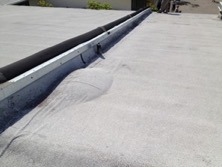
Roof Blistering
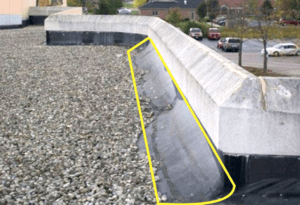
Roof Tenting
Heat
Heat alone can degrade certain roofing materials, especially petroleum-based membranes like built-up roofs (BUR), modified bitumen, and EPDM (ethylene propylene diene terpolymer). These materials contain volatile compounds, the purpose of which is to keep asphalt-based membranes waterproof and, to some degree, flexible.
They are called volatile compounds because they boil at a relatively low temperature. The sun beating down on a roof (especially a black one) is enough, over time, to slowly vaporize these compounds. The compounds comprise a significant-enough percentage of the roof membrane that their loss results in the roof becoming more brittle and less resistant to moisture intrusion, and also in membrane shrinkage that creates additional stress. Stresses caused by resistance to shrinkage are typically relieved first by cracking, then through splitting.

Alligatoring of an asphalt-based roof membrane
Wind
Wind can affect roof structures both through uplift and through downward forces. Wind inflation can occur within the building structure and within the roof assembly. Note that wind forces can vary across a roof, creating differential stresses across the roof assembly. For instance, wind scouring can cause the gravel and stone on ballasted roofs to be displaced. This is most common at the corners of the roof. Additionally, wind can combine with rain or hail to enhance their capacity for damage.
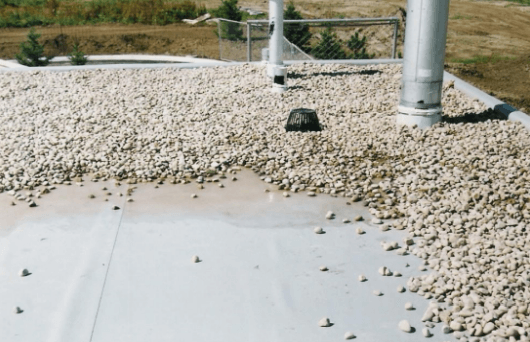
Ballasted roof with displaced ballast from the wind

Wind-damaged metal coping on roof structure
Impact
In addition to the impact from hail, roofs may experience impact from snow and ice falling from overhanging trees and roofs, falling tree limbs, thrown objects, and objects dropped or knocked over by workers. These types of impact can puncture the roof membrane and allow moisture intrusion.
Moisture
Moisture may affect a roof in the form of liquid or vapor trapped within the roof assembly, which can cause material degradation, such as blistering, or in the form of water collecting on low areas of the roof surface, called ponding or pooling. Ponded water – that is, water remaining pooled on the roof 48 hours after a rain event – increases the chances of roof leakage and vegetation growth. Plus, since water is very heavy, ponding increases the chances of the roof’s structural failure.
Ponding may be the result of:
- inadequate roof slope;
- blocked roof drains, or
- a sagging roof structure.
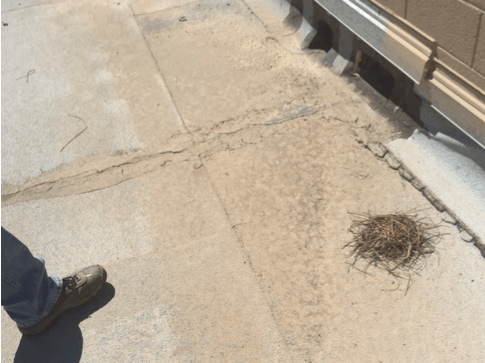
Area of ponding near scuppers
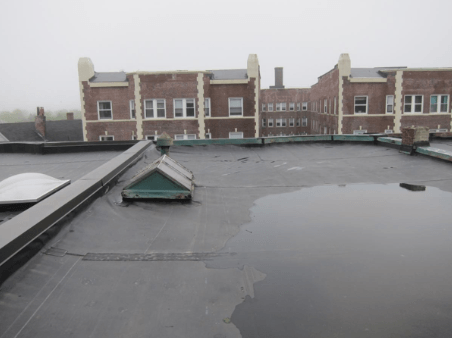
Area of active ponding on the roof
Microbial Growth
Algae is the most common type of microbial growth on low-slope roofing, but it’s not the only type. In addition to the possibility of direct damage to membranes, microbial growth can hold moisture against the roof, and because it’s slippery, it’s a potential safety hazard for those walking the roof for inspection or repair.

Red algae on low-slope roof
Pollutants
Pollutants may be airborne in the form of chemical vapors or particulates. Sources may include industrial emissions, agricultural chemicals (pesticides and fertilizers), acid rain, and other sources.
Pollutants may also be produced by roof-mounted equipment exhausting airborne mist-like residues made from petroleum, or animal fat from mechanical or restaurant operations.
Pollutants can also damage a roof if a catchment isn’t properly installed. For instance, the grease residue discharged as a result of a missing grease catchment box or incorrectly used down blast fan will damage the roof membrane.
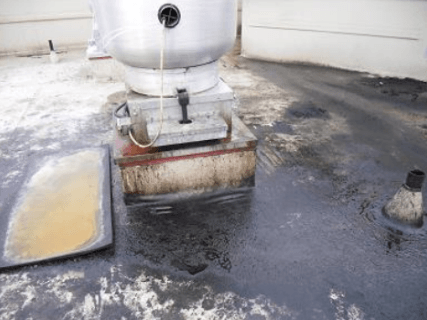
Grease saturation on low-slope roof
New Materials
In the continuing quest for high performance, the roofing industry is constantly exposed to new materials. Materials for decks, air retarders, insulation, cover boards, flashings, and weather membranes may be used in a huge number of combinations and environmental conditions. The following are some of the concerns related to new materials.
Testing/Durability
Although roof system components may be tested as individual materials, it’s their performance as part of an integrated roof system that is most important. Testing as an individual material will establish some performance baselines, but in-service performance will be unpredictable.
Testing of various materials may be carried out by a number of organizations or agencies. Testing is typically limited to specific categories and may fail to identify the potential for significant problems to develop. These problems may be related to chemical compatibility or durability. Although accelerated laboratory testing is better than nothing, field-testing provides the only real predictor of a roofing material’s long-term performance.
Design
Roof assembly components must each be considered as part of an integrated system, and in addition to compatibility with other assembly components, the designer must anticipate how those compatibilities may be affected by environmental conditions that often change seasonally, and may be affected by changes in building use or changes in the HVAC system. This is especially true for any changes that may affect interior humidity levels or air pressure.
The design may also be complicated by a lack of available test results or information on newer materials that the designer may receive pressure to use. Until a material is tested in the field, its longevity and compatibility are highly unpredictable, causing many complications for newer materials.
Installation
With newer roofing materials, problems may take a while to become apparent. Over time, it may become obvious that some materials must be installed in a certain manner. It may be that certain combinations of materials must be avoided, or that certain types of attachment, flashing, drainage, or termination methods work better than others. Until a newer material has been in extended field service under different environmental conditions, the optimum installation methods may not be known.
Roof Design
The large-scale nature of a low-slope roof makes it susceptible to more complex problems than a small roof. The complex problems are also directly correlated to the increasing complexity of roof design. Note that expansion and contraction are cumulative, meaning that they take place to a greater extent on larger, unbroken or undivided expanses of the roof.
Additionally, one major cause of membrane splitting is from the movement of unanchored insulation boards, and this occurs more frequently on large roof surfaces because of the space available for the boards to move and create membrane stress concentrations.
Expansion joints are installed to separate large roof areas into smaller ones in order to reduce problems from movement during thermal expansion and contraction. To accommodate this, roofs lengths in general should not exceed 400 square feet without an expansion joint. Increasingly complex roof geometry can complicate the installation of expansion joints.
Drainage
Inadequate drainage is a common cause of roof failure. According to the International Plumbing Code (IPC), a slope of one-quarter inch-per-foot is considered the minimum for proper drainage. Any less and ponding is probable. On the other hand, a slope of a half-inch-per-foot or more may cause roofing materials to subside.
Another consideration for roof drainage is the roof length and structural members that support the large expanses of the roof. Long structural framing spaces are more likely to deflect (sag) than those supporting shorter spans. Consequently, long structural framing spaces are susceptible to ponding. This leads to a vicious cycle such that the ponding increases sagging, which, in turn, causes more ponding. Eventually – especially if the roof drain becomes clogged – this condition can result in catastrophic roof structural failure. Ponding on roofs with defective or failed membrane lap joints and flashing can allow significant moisture intrusion of the roof system, too.
Drains should be located at points of minimum deflection and height. Therefore, drains should be located at mid-span of roof joints because it is the location of maximum deflection, and not at columns for bearing walls, in order to avoid ponding. The proper location and size of a drain will remove rain and snowmelt effectively. It’s also important to note whether rooftop-mounted features (such as HVAC units and solar panels) don’t obstruct the flow of water to the drain.
The least expensive way to build a roof is dead-level, which is a roof or section without any pitch. These types of roofs will inevitably have depressions that cause water to pond, and the inspector will likely encounter them due to their initial low cost of construction.
Workmanship
The general consensus among roofing professionals is that poor workmanship is responsible for the majority of roof failures. As mentioned, financial pressures, often connected with pressure to complete work by a deadline, cause a great deal of faulty workmanship. To maintain schedules, general contractors sometimes pressure roofing contractors to move ahead with the installation under improper conditions, such as wet or severely cold weather.
The mistakes made during the construction of a low-slope roof often aren’t apparent immediately after completion of the project. The problems take time to develop and sometimes even longer to notice
Conclusion
As described, there is a multitude of reasons why a roof may fail. Some are related to economics, while others are more technical. Signs of roof damage and failure – such as ponding, blistering, and cracking – may be more obvious than damage or failure caused by incompatible roofing materials, especially built-up roofs or inverted roof membrane assemblies, since the membranes aren’t visible. In any situation, a commercial property inspector should note any signs of damage, and consult the manufacturer’s specifications or a commercial roofing professional, as needed.
Roofing systems are the most expensive components for building owners to replace, so periodic inspections are of the utmost importance. Commercial property inspectors should make sure their clients understand that many roofing problems take time to develop but can be mitigated before costly repairs are required if the system is inspected regularly.
Additional Commercial Inspector Resources:
Inspecting Low-Slope Roofs Course for Commercial Property Inspectors
Commercial Property Inspection Technical Course (Live)
Low-Slope Roof Components
The History of Low-Slope Roofs

